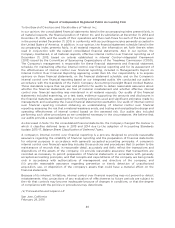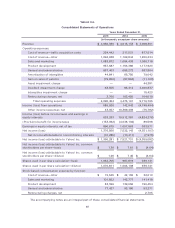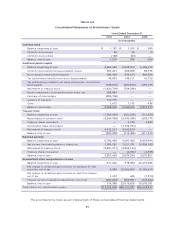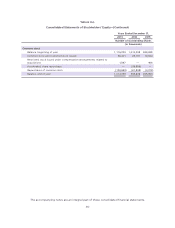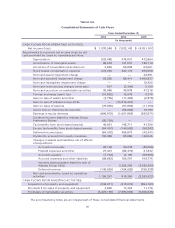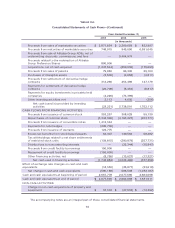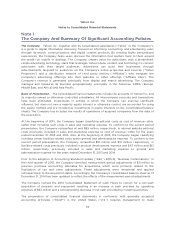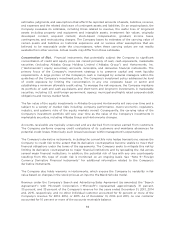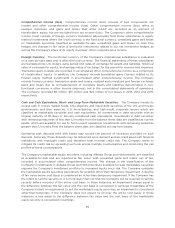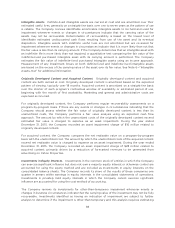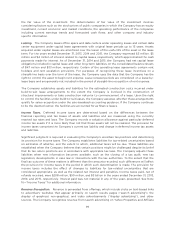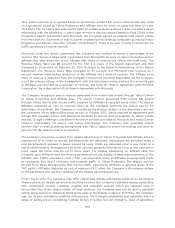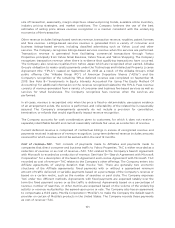Yahoo 2015 Annual Report Download - page 99
Download and view the complete annual report
Please find page 99 of the 2015 Yahoo annual report below. You can navigate through the pages in the report by either clicking on the pages listed below, or by using the keyword search tool below to find specific information within the annual report.Comprehensive Income (loss). Comprehensive income (loss) consists of two components, net
income and other comprehensive income (loss). Other comprehensive income (loss) refers to
revenue, expenses, and gains and losses that under GAAP are recorded as an element of
stockholders’ equity but are excluded from net income (loss). The Company’s other comprehensive
income (loss) consists of foreign currency translation adjustments from those subsidiaries or equity
method investments where the local currency is the functional currency, unrealized gains and losses
on marketable securities classified as available-for-sale, unrealized gains and losses on cash flow
hedges, net changes in fair value of derivative instruments related to our net investment hedges, as
well as the Company’s share of its equity investees’ other comprehensive income.
Foreign Currency. The functional currency of the Company’s international subsidiaries is evaluated
on a case-by-case basis and is often the local currency. The financial statements of these subsidiaries
are translated into U.S. dollars using period-end rates of exchange for assets and liabilities, historical
rates of exchange for equity, and average rates of exchange for the period for revenue and expenses.
Translation gains (losses) are recorded in accumulated other comprehensive income as a component
of stockholders’ equity. In addition, the Company records translation gains (losses) related to its
foreign equity method investments in accumulated other comprehensive income. The Company
records foreign currency transaction gains and losses, realized and unrealized and foreign exchange
gains and losses due to re-measurement of monetary assets and liabilities denominated in non-
functional currencies in other income (expense), net in the consolidated statements of operations.
The Company recorded $6 million, $15 million and $22 million of net losses in 2013, 2014 and 2015,
respectively.
Cash and Cash Equivalents, Short- and Long-Term Marketable Securities. The Company invests its
excess cash in money market funds, time deposits, and liquid debt securities of the U.S. and foreign
governments and their agencies, U.S. municipalities, and high-credit corporate issuers which are
classified as marketable securities and cash equivalents. All investments in debt securities with an
original maturity of 90 days or less are considered cash equivalents. Investments in debt securities
with remaining maturities of less than 12 months from the balance sheet date are classified as current
assets, which are available for use to fund current operations. Investments with remaining maturities
greater than 12 months from the balance sheet date are classified as long-term assets.
Operating cash deposits held with banks may exceed the amount of insurance provided on such
deposits. Generally, these deposits may be redeemed upon demand and are maintained with financial
institutions with reputable credit and therefore bear minimal credit risk. The Company seeks to
mitigate its credit risk by spreading such risk across multiple counterparties and monitoring the risk
profiles of these counterparties.
The Company’s marketable equity securities, including Alibaba Group and Hortonworks, are classified
as available-for-sale and are reported at fair value, with unrealized gains and losses, net of tax,
recorded in accumulated other comprehensive income. The change in the classification of the
Company’s investments in Alibaba Group and Hortonworks to available-for-sale marketable securities
exposes the Company’s investment portfolio to increased equity price risk. The Company evaluates
the marketable equity securities periodically for possible other-than-temporary impairment. A decline
of fair value below cost basis is considered an other-than-temporary impairment if the Company has
the intent to sell the security or it is more likely than not that the Company will be required to sell the
security before recovery of the entire cost basis. In those instances, an impairment charge equal to
the difference between the fair value and the cost basis is recognized in earnings. Regardless of the
Company’s intent or requirement to sell the marketable equity securities, an impairment is considered
other-than-temporary if the Company does not expect to recover the entire cost basis; in those
instances, a loss equal to the difference between fair value and the cost basis of the marketable
equity security is recognized in earnings.
95


